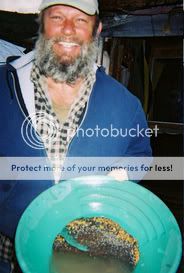The age of Discovery;
It's easy for GOLD prospectors to become "myopic". It's a case where we develop a view of the world around us based on a narrow view formed from our limited "experience".
For example, in my early years, when GOLD prospecting and spending hours digging and scraping dirt, searching for minerals in any form, I would find an exciting specimen in the form of a thumb sized piece of chrysocola. It pops right out! I went through the trouble of taking it to the Arizona Department of Mines and Mineral Resources. In return, I would get humiliated with comments like; "Well, you're a long ways from a copper mine!"
Learning from our predecessors;
Early Spanish explorers (Conquistadores) AFTER having sailed across the Atlantic Ocean went to work prospecting North America looking for the lost city of "El Dorado".
https://en.wikipedia.org/wiki/El_Dorado
https://en.wikipedia.org/wiki/Conquistador
They shipped TONS of GOLD and Silver back to Spain!
The Conquistadores used the best tools available, their eyeballs, in their search for what today, we call "iron gossans". We know now as they probably knew then, an iron gossan results from the "halo" created by Iron sulfides becoming oxidized forming an orange - red, sometimes yellow when arsenic is present, very visible coloration of the surface.
Minerals like copper have a range of blue and green coloration. A little copper goes a long way when it becomes an oxide! Gold is often associated with iron minerals and copper. Iron and copper are good visual markers. Arsenic related to arsenopyrite is a very important visual marker. These minerals express themselves because their concentration is anomalous to the degree that we can "see" them.
Minerals in soil;
What is Soil?
Natural Resources Conservation Service
U.S. DEPARTMENT OF AGRICULTURE
https://www.nrcs.usda.gov/resources/edu ... ansfers%2C
A good reference, Nature.com provides a better definition with illustrations:
https://www.nature.com/scitable/knowled ... -67647639/
We can summarize from the information we read that soils are mostly organic and yes, there are minerals in the soil.
Soil Geochemistry;
Much study in recent decades has been directed toward various means and methods using sensitive analytical tools. The tools range from AA and ICP spectrometers for inorganic analysis of soils and plants to optical methods using laser technology and x-ray fluorescence spectrometers. The measurements are in parts per million and for GOLD, measurements in parts per billion.
Oxides of all of the metals are plentiful except those metals that do NOT form oxides like GOLD!

Tools, APPs, GOLD and the Cloud;
The Geochem App can be found here...
https://www.sciaps.com/industries/geoch ... JcQAvD_BwE
A whole new world of analysis?
The Geochem Pro App?
Ready to Order?
Where's the Gold?
START an Order and hit the SUBMIT button!
Don't confuse minerals like Lithium with GOLD.
https://en.wikipedia.org/wiki/Lithium_oxide
We are flooded with technology and claims of all sorts having little or no basis in material fact. Lots of "Buzz" words!
Wheat or Chaff?
What it boils down to for the common GOLD prospector is being able to separate the wheat from the chaff. We aren't going to mine micron GOLD or nano GOLD. We aren't going to mine Chaff sized particles of GOLD. Rational prospectors don't get excited about fine gold. The reason is obvious. Fine GOLD takes the effort involved in clean-up to another level - beyond which, the laws of diminishing returns prevail.
A successful Placer miner wants to mine "wheat" sized GOLD or larger. Prospectors have an objective. The objective is to find GOLD in sufficient quantity to warrant a prudent man to expend his money! To that end, if we look around at our fellow GOLD prospectors, we can ask, what are they doing right and what are they doing wrong?
You be the judge!

- Geowizard


